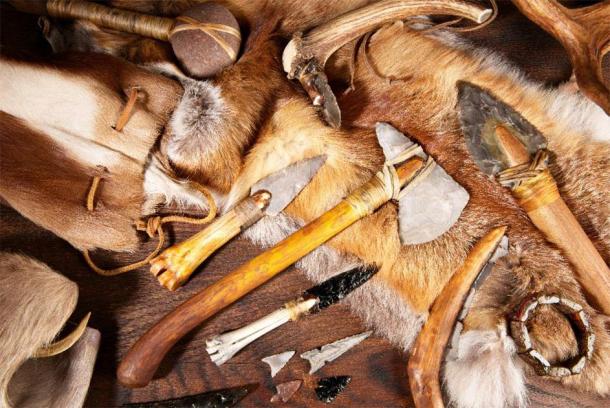One of the greatest mysteries in science is why there is only one species of humans in the world today. In the past, there were several and they often co-existed for considerable periods. These past human species are modern humans’ older ancestors. Now, researchers believe that they know why our ancestors disappeared. Since they could not adapt to climate change the past human species became extinct, unlike Homo sapiens .
Past Human Species Who Shared the Planet
For millennia there was more than one human species roaming the earth. Indeed, they often interbred with each other, and for this reason modern humans have genes of long-extinct past human species. A group of Italian researchers decided to examine why our ancestors vanished from the face of the earth and why we were the only ones to survive.
The researchers wrote in One Earth that ‘At least six different Homo species populated the World during the latest Pliocene to the Pleistocene.’ They focused on why Homo habilis, Homo ergaster, Homo erectus, Homo heidelbergensis, and Homo neanderthalensis , all went extinct. These species of homo disappeared, the authors of the study are quoted in Science Daily as saying, “despite technological innovations including the use of fire and refined stone tools and the formation of complex social networks.”

Stone tools and simple clothing weren’t enough to save past human species. ( ExQuisine /Adobe Stock)
Recreating the Prehistoric Climate
The Italian researchers hypothesized that climate change played a key role in the demise of species such as the Neanderthals. All of them had a climatic niche, that is a climate that they had adapted to successfully. H. sapiens were included in the study to determine why they survived, unlike their relatives. Researchers examined an extensive fossil database spanning over a million years. They developed a climate emulator to create a model of past climates and how they changed over 5 million years.
Climate Change and the Extinction of Past Human Species
Using factor analysis, the experts were able to calculate how the changes in temperature and rainfall impacted the climate niche of each species . For three species, H. heidelbergensis, H. erectus, and H. neanderthalensis , they found that ‘their climatic niche widths shrunk suddenly just before they vanished,’ reports One Earth .
This means that the climate changed, making their environment challenging and they could not adapt to the new environment. This contributed greatly to their extinction. In the case of the Neanderthals, this was “made even worse by competition with H. sapiens,” according to Dr. Pasquale Raia of Naples University.

Neanderthals had to compete with Homo sapiens too. ( ginettigino /Adobe Stock)
The data from the climatic simulator offers strong evidence that the three extinct species of Homo were not able to cope with rising or cooling temperatures. Raia is quoted by Science Daily as saying that “We were surprised by the regularity of the effect of climate change.”
While there is evidence, based on the geographical distribution of remains, that the archaic humans tried to move to more favorable climates they were not able to adjust to the new conditions. Dr. Raia is quoted by The Independent as saying that:
“It was crystal clear, for the extinct species and them only, that climatic conditions were just too extreme just before extinction and only in that particular moment.”
Why Modern Humans Survived
In One Earth the study’s authors wrote that ‘Our results show striking differences in vulnerability between H. sapiens and the significantly more vulnerable extinct species .’ It appears that our Homo sapiens ancestors were less vulnerable to environmental changes. They had a much wider climatic niche, that is to say, that they could endure and adapt to changing temperatures and environmental conditions. Their cognitive abilities and technologies, such as fire , meant that they could ‘mitigate the effects of climate change on their survival by effectively manipulating their own microclimates or moving rapidly to settle under better conditions’ states One Earth .
However, the study noted that climate change also often had a profound impact on H. sapiens and could again in the future. At a time of rapid climate change the results of the study on early humans’ extinctions are truly relevant. Dr. Raia is quoted by The Independent as saying that “It is worrisome to discover that our ancestors, which were no less impressive in terms of mental power as compared to any other species on Earth, could not resist climate change.”
A Thunderous Warning Message
Unlike in the past, the current changes in the climate are almost certainly linked to human activities. The Independent quotes Dr. Raia as stating that “I personally take this as a thunderous warning message.” The research shows that modern humans are as vulnerable as our ancient extinct relatives, such as the Neanderthals, to climate change . We too may one day be as helpless as they were when their environment changed. Just because we successfully adapted in the past , that does not mean that we can in the future.
Top image: Several past human species went extinct due to climate change. Source: regis allouet /Adobe Stock
By Ed Whelan
Related posts:
Views: 0
 RSS Feed
RSS Feed















 October 17th, 2020
October 17th, 2020  Awake Goy
Awake Goy  Posted in
Posted in  Tags:
Tags: 
















